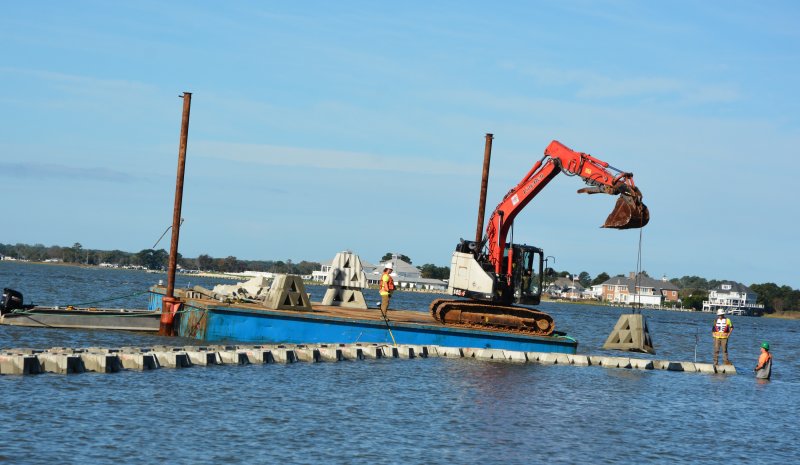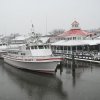Work wrapping up on Phase 1 of Thompson Island project
A project in Rehoboth Bay designed to protect the southern end of Thompson Island from continued erosion has wrapped up.
The project is a partnership among the Delaware Center for the Inland Bays, the Delaware Department of Natural Resources and Environmental Control, Delaware State Parks and Sovereign Consulting Inc. Work included the in-water installation of more than 300 wave attenuation devices about 100 feet from the shoreline.
Bob Collins, Center for the Inland Bays programs and facilities manager, led a boating excursion out to the project site as the last wave attenuation device, a large, pyramid-shaped structure made of concrete, was dropped into the water.
The island feels the brunt of five miles of fetch, the distance the wind blows in a constant direction, along the Rehoboth Bay, said Collins. The concrete structures each weigh about 1 ton and are designed to let water flow through them, which helps absorb the energy, he said.
Regular riprap deflects the energy, which can make things worse in other areas because the energy has to go somewhere, said Collins.
Doug Janiec, Sovereign Consulting senior restoration ecologist, designed the project. He said it is designed to dampen the wave energy by 90%.
“It’s already working,” said Janiec, standing in chest-deep water and pointing to how calm the water was on the island side of the project despite strong winds. “The waves don’t stand a chance.”
In addition to reducing wave energy, the devices will serve as a habit to fish, shellfish and aquatic plants, said Janiec.
Concrete company Gillespie Precast made all the devices at its plant outside Greenwood off Route 16.
Jim Talbot, Gillespie Precast executive vice president, took the opportunity of the media availability to see the company’s product in the water.
The installation of the wave attenuation devices took about three weeks and cost about $1.1 million. It’s also just Phase 1 of a multi-phase project, said Collins. Other phases include work closer to the jetties for the Lewes-Rehoboth Canal and the side of the island facing Dewey Beach, but as of right now, there’s no funding for those, he said.
That’s part of the reason for moving forward with the first phase, said Collins. It serves as an educational opportunity and enables CIB to take people on tours to see how well it works, he said.
Thompson Island is part of Delaware Seashore State Park and was dedicated as a nature preserve in 2000. The island holds deep cultural significance for the Nanticoke Indian Tribe, which used the land as a ceremonial gathering place. Members of the tribe took a boat tour of the project area in June 2024 to bless the island and the project.


Chris Flood has been working for the Cape Gazette since early 2014. He currently covers Rehoboth Beach and Henlopen Acres, but has also covered Dewey Beach and the state government. He covers environmental stories, business stories and random stories on subjects he finds interesting, and he also writes a column called Choppin’ Wood that runs every other week. He’s a graduate of the University of Maine and the Landing School of Boat Building & Design.






























































